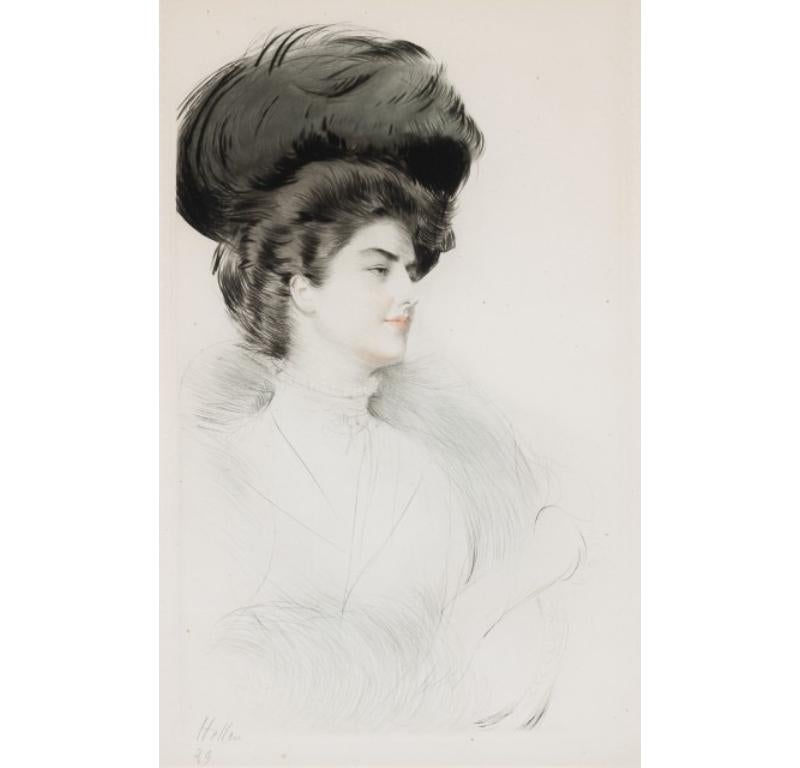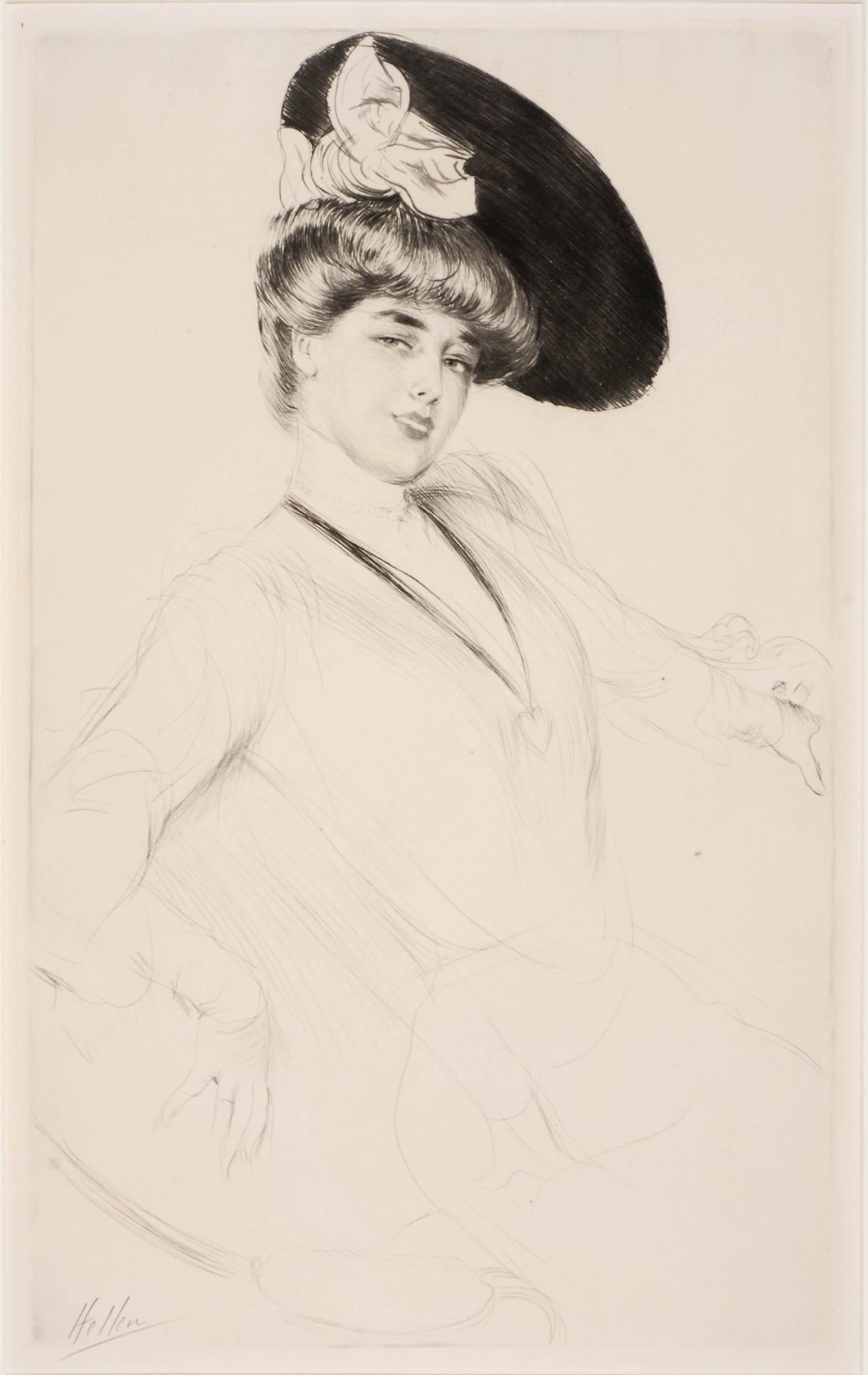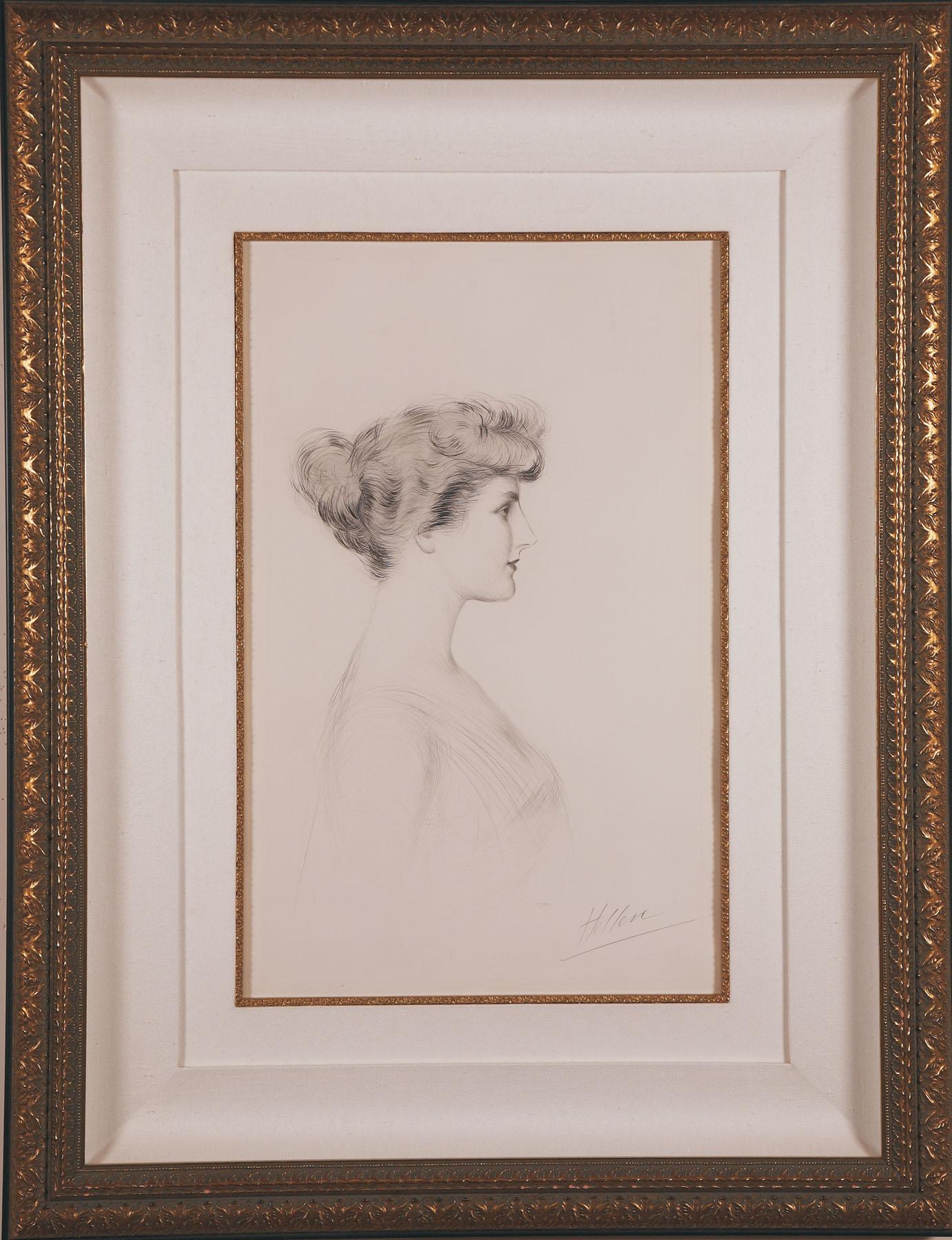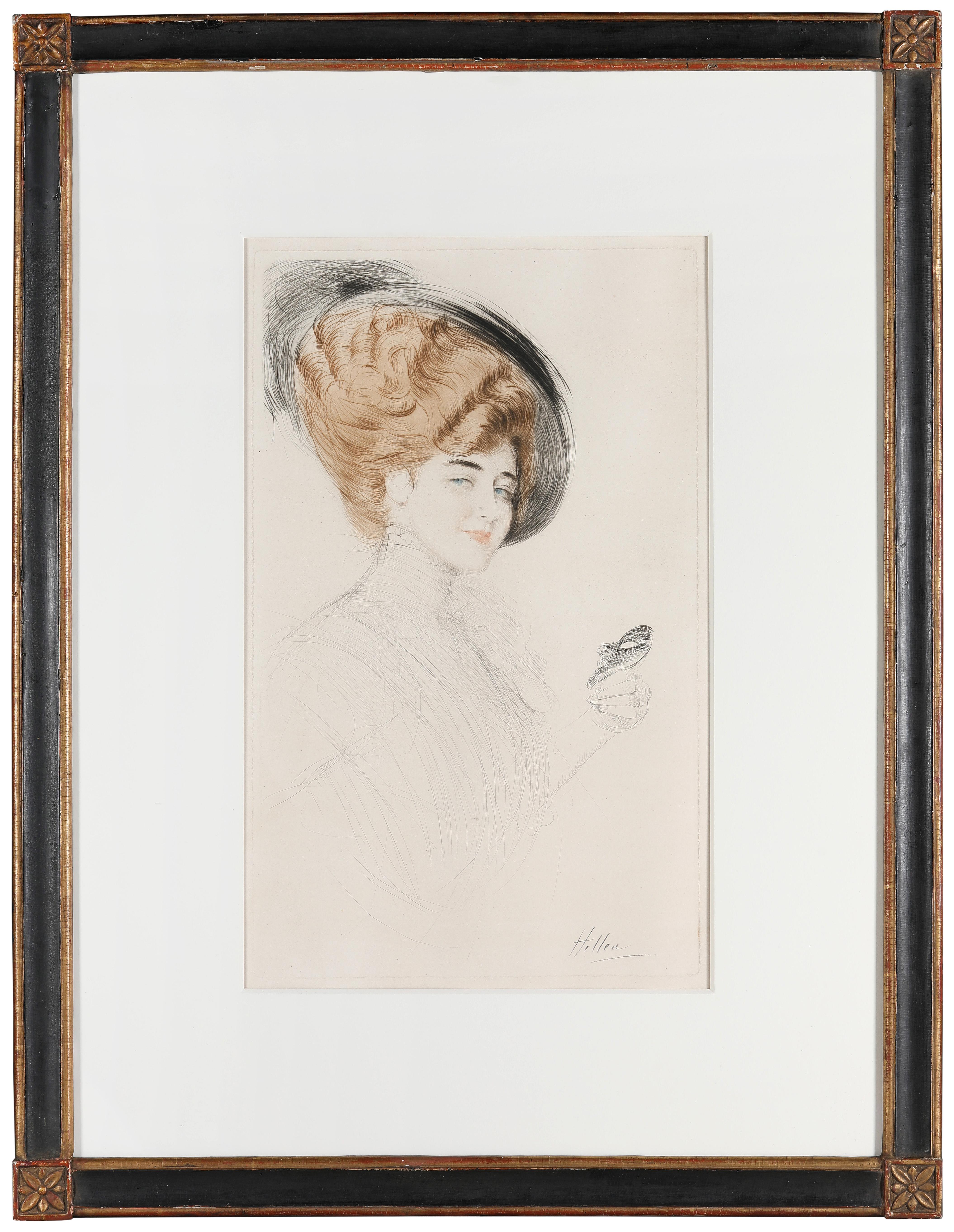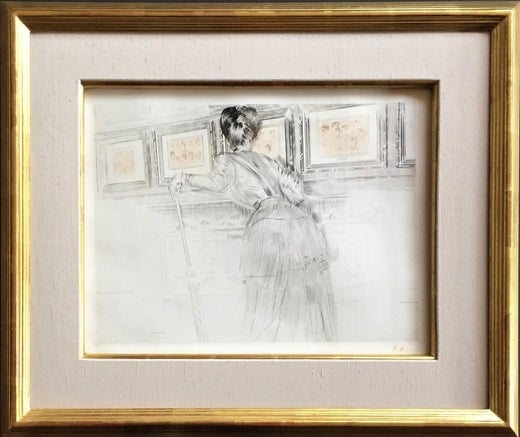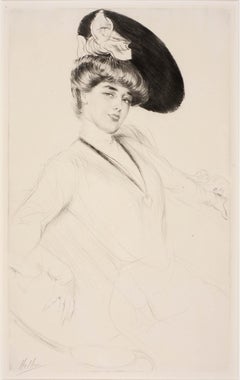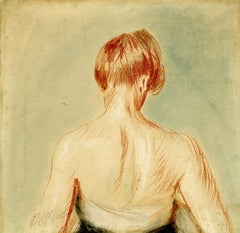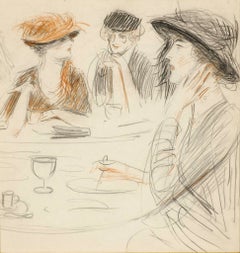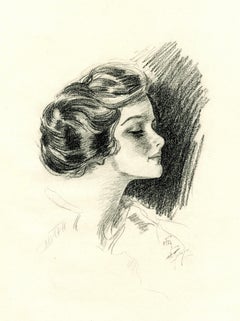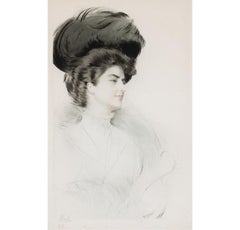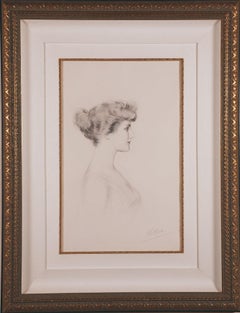Items Similar to Portrait de femme en buste, de profil a gauche, un tres large ruban noir du cou
Want more images or videos?
Request additional images or videos from the seller
1 of 11
Paul César HelleuPortrait de femme en buste, de profil a gauche, un tres large ruban noir du cou1901
1901
$2,500
£1,908.95
€2,173.41
CA$3,510.39
A$3,837.55
CHF 2,030.24
MX$45,922.44
NOK 25,831.84
SEK 23,646.43
DKK 16,234.03
About the Item
Portrait de femme en buste, de profil a gauche, un tres large ruban noir du cou, Mme Marthe Letellier
Drypoint, 1900-1901
Signed in pencil lower left (see photo)
Titled in pencil lower center in pencil (see photo)
Very small edition
Titled in pencil in the lower center of the image: "Madame Henri Letellier" in pencil
Translation from IFF: Bust portrait of a woman, in profile to the left, a very wide black ribbon at the neck, Ms. Letellier
Reference: IFF Vol 10, No. 206
SEM depicted the Grand Hotel (Henri Letellier, Marthe Letellier, SEM and Paul Helleu), from Monte Carlo, 2nd Serie, c. 1910 (see photo)
(see photo)
Marthe (ne Fourton) Letellier (1878-1954) was one of Helleu's favorite models
Condition: Excellent, professionally cleaned
Image/Plate size: 21 1/2 x 13 1/4 inches
- Creator:Paul César Helleu (1859-1927, French)
- Creation Year:1901
- Dimensions:Height: 21.5 in (54.61 cm)Width: 13.25 in (33.66 cm)
- Medium:
- Movement & Style:
- Period:
- Condition:
- Gallery Location:Fairlawn, OH
- Reference Number:Seller: FA124741stDibs: LU14014352692
Paul César Helleu
Rich impression with dramatic drypoint burr and tone no other artist epitomizes the whole atmosphere of elegance and hedonistic pleasure which pervaded Paris society at the first decade of the century as does Helleu. A close friend of Proust and the inspiration for one of the principal characters in La Recherche du Temps Perdu, Helleu’s whole life style echoed the incomparable elegance and flow of his drawing, the sheer style of his art, and his eye for the poses of the beautiful women who were his friends and his patrons. During the 1870’s, Helleu had come to know the painters of Impressionism and also artists Sargent and Whistler who became his special friends and inspiration. By the early 1880’s, he had already developed the quality of expressive sweeping line, which is the essence of his drawing, but in 1885 he was encouraged by Tissot to try working on prints in drypoint. At this time, Tissot had decided, after the death of his lover and model Kathleen Newton, to travel to the Holy Land on an artistic pilgrimage. Having decided he would no longer engrave, he gave Helleu his diamond stylus…a literal and figurative “passing of the baton”. It was in the incision and texture of drypoint that his art was to reach one of its greatest peaks. He had an innate feel for the balance between a lightly curving stroke and the deeply cut highly tonal burr of the strongest drypoint. Around the turn of the century he started to combine drypoint with multi-inking in colors, the areas of color restricted to such touches as the bows on the hats, the hair color or the red of the lips. The plate was drawn at a single sitting, and then the color inks were brushed onto it. The results are some of the most splendid and decorative of all Belle Époque prints.
About the Seller
5.0
Recognized Seller
These prestigious sellers are industry leaders and represent the highest echelon for item quality and design.
Gold Seller
Premium sellers maintaining a 4.3+ rating and 24-hour response times
Established in 1978
1stDibs seller since 2013
834 sales on 1stDibs
Typical response time: <1 hour
Associations
International Fine Print Dealers Association
- ShippingRetrieving quote...Shipping from: Akron, OH
- Return Policy
More From This Seller
View AllMiss Taylor
By Paul César Helleu
Located in Fairlawn, OH
Miss Taylor
Drypoint, c. 1900
Signed in pencil lower left (see photo)
Small edition, about 10
Very rich impression, full of burr
Condition: Excellent
Image size: 21-1/4 x 13-1/4"
She...
Category
Early 1900s Art Nouveau Portrait Prints
Materials
Drypoint
Untitled (Young woman seen from the back)
By Paul César Helleu
Located in Fairlawn, OH
Untitled (Young woman seen from the back)
Sanguine crayon, charcola and watercolor on paper, c. 1910
Signed with the estate stamp, Lugt 5169 lower left corner
Provenance:
Estate of ...
Category
Early 1900s Impressionist Figurative Drawings and Watercolors
Materials
Charcoal
Tea at the Ritz, New York
By Paul César Helleu
Located in Fairlawn, OH
Tea at the Ritz, New York
Colored chalk, 1912
Signed with the estate stamp verso. (see photo)
Authenticated by the artist's daughter, Mme Paulette Johnston.
Image size: 10 5/8 x 10 1...
Category
1920s Art Nouveau Drawings and Watercolor Paintings
Materials
Chalk
Young Lady in Profile
By Harrison M. Fisher
Located in Fairlawn, OH
Young Lady in Profile (Dorothy Gibson)
Graphite on paper, c. 1915
Signed lower right (see photo).
The sitter for this drawing, along with a huge number of Harrison Fisher’s works, i...
Category
1910s American Impressionist Drawings and Watercolor Paintings
Materials
Graphite
Berthe
By James Jacques Joseph Tissot
Located in Fairlawn, OH
Berthe
Etching with drypoint, 1883
Signed in the plate (see photo)
This etching was inspired by an 1882/3 pastel which the artist included in his ambitious "Femme a Paris" exhibition at Galerie Sedelmeyer, Paris, in 1885.
Reference: Beraldi 65
Wentworth 74, published state
Tissot 76
Condition: Excellent
Plate/Image size: 14 1/4 x 11 inches
Sheet size: 19 1/2 x 15 inches
Frame size: 23-1/2 x 20-1/4 inches
Donald Morris Gallery, Birmingham, Michigan (Morris had a distinguished collection of Tissot prints...
Category
1880s Impressionist Portrait Prints
Materials
Etching
Standing Woman in Profile
By Frederick Carl Frieseke
Located in Fairlawn, OH
Standing Woman in Profile
Pen and ink drawing, c. 1900
Unsigned
Estate authentication verso by Frances Frieseke Kilmer (Mrs. Kenton Kilmer, 1914-1998) (see photo)
Condition: Excellen...
Category
Early 1900s American Impressionist Figurative Drawings and Watercolors
Materials
Ink
You May Also Like
Bust of a young woman in profile
By Paul César Helleu
Located in Naples, Florida
Bust of a young woman in profile
Paul-César Helleu (1859-1927)
JEUNE FEMME EN BUSTE, DE PROFIL À DROITE
Color drypoint, circa 1900, on wove paper, signed and annotated 29 in pencil,...
Category
19th Century Portrait Paintings
Materials
Paper, Drypoint, Etching
$4,250 Sale Price
50% Off
"Portrait of Madame Georges Menier" By Helleu
By Paul César Helleu
Located in Hinsdale, IL
HELLEU, PAUL CÉSAR
(1859 - 1927)
MADAME GEORGES MENIER
Montesquiou XXI
Drypoint in colors, c. 1900
Signed in pencil, lower right
Printed on wove paper
Full Margins
22 1/4” x 13...
Category
Early 19th Century Art Nouveau Figurative Prints
Materials
Drypoint, Etching
"Madame Georges Menier" Portrait, by Paul Cesar Helleu
By Paul César Helleu
Located in Hinsdale, IL
HELLEU, PAUL CÉSAR
(1859 -1927)
"MADAME GEORGES MENIER"
Montesquiou XXI
Drypoint in colors, c. 1900
Signed in pencil, lower right
Printed on wove paper
Full...
Category
Early 20th Century Art Nouveau Portrait Prints
Materials
Drypoint
Elegant Woman Profile - Original Etching, Printed signature
By Paul César Helleu
Located in Paris, IDF
Paul César Helleu
Elegant Woman Profile, 1913
Original Etching
Printed signature
On vellum 26 x 20 cm (c. 10.5 x 8 inch)
Very good condition, light defects at the edge of the sheet
Category
1890s Art Nouveau Portrait Prints
Materials
Etching
Paul César Helleu "Le masque" Color Etching, Hand-Signed, Art Nouveau
By Paul César Helleu
Located in Eltville am Rhein, DE
Paul César Helleu
Vannes 1859 - 1927 Paris
"Le masque"
Color etching on handmade paper
Signed in pencil lower right
Image: 52.5 x 33 cm
Frame: 93 x 72 cm
Old 19th-century frame, acid...
Category
Early 1900s Art Nouveau Figurative Prints
Materials
Etching
La Duchesse de Marlborough, Consuelo Vanderbilt
By Paul César Helleu
Located in Storrs, CT
Paul César Helleu. La Duchesse de Marlborough, Consuelo Vanderbilt. c. 1901. Drypoint. 21 1/2 x 13 3/4 (sheet 24 x 15). A rich impression printed o...
Category
Late 19th Century Impressionist Portrait Prints
Materials
Drypoint, Etching
$16,000 Sale Price
36% Off
More Ways To Browse
Pierre Yves Riveau
Piranesi Architectural Etchings
Piranesi Views Of Rome
Prayer At Valley Forge
Richard Yarde
Robert Elliot
Robert Gibbings
Romare Bearden Poster
Ronald King
Roy Lichtenstein Reflections
Rufino Tamayo Signed
Russian Woodcut
Saint Genie
Salvador Dali Green
Salvador Dali Signed Prints Bullfight
Secession Poster Vienna
Shepard Fairey Large
Signed Charles Bragg
